Abstract
Roots of sunflower plants (Helianthus annuus L. var. Mammoth Russian) subjected to L12:D12, L18:D6, and L12:D12 followed by continuous light all display rhythms of about 12 hours for glutamine synthetase (GS) activity (transferase reaction) with one peak in the `light phase' and one in the `dark phase.' Root energy charge (EC = ATP+½ADP/ATP+ADP+AMP) is directly correlated with GS, but the GS rhythm is better explained as the result of a rhythmic adenine nucleotide ratio (ATP/ADP+AMP) that regulates enzyme activity through allosteric modification. When L12:D12 plants are subjected to free-running conditions in continuous darkness, only diurnal rhythms for GS and EC, with peaks in the dark phase, remain. The 12-hour root rhythms for GS and EC appear to be composed of two alternating rhythms, one a diurnal, light-dependent, incompletely circadian light phase rhythm and the other a light-independent, circadian dark phase rhythm.
Only glutamine, of the root amino acids, displays cyclical changes in concentration, maintaining under all conditions a 12-hour rhythm that is consistently synchronized with, but nearly always inversely correlated with, GS and EC rhythms.
Full text
PDF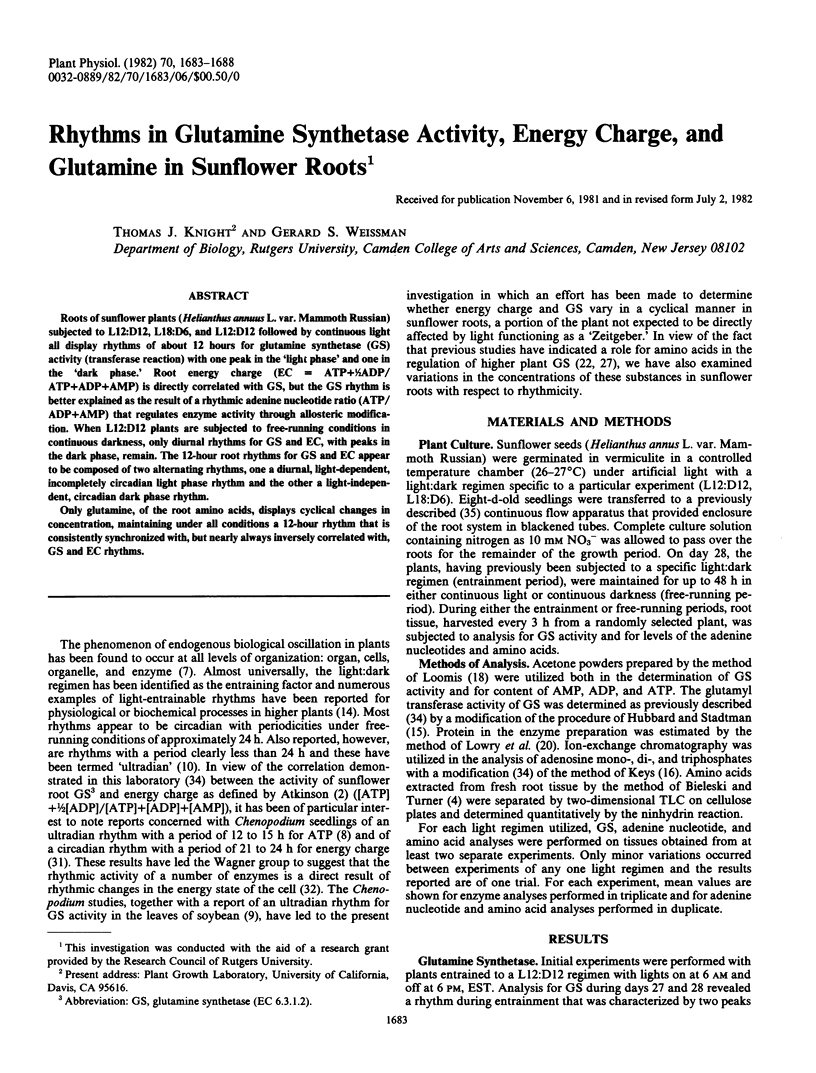
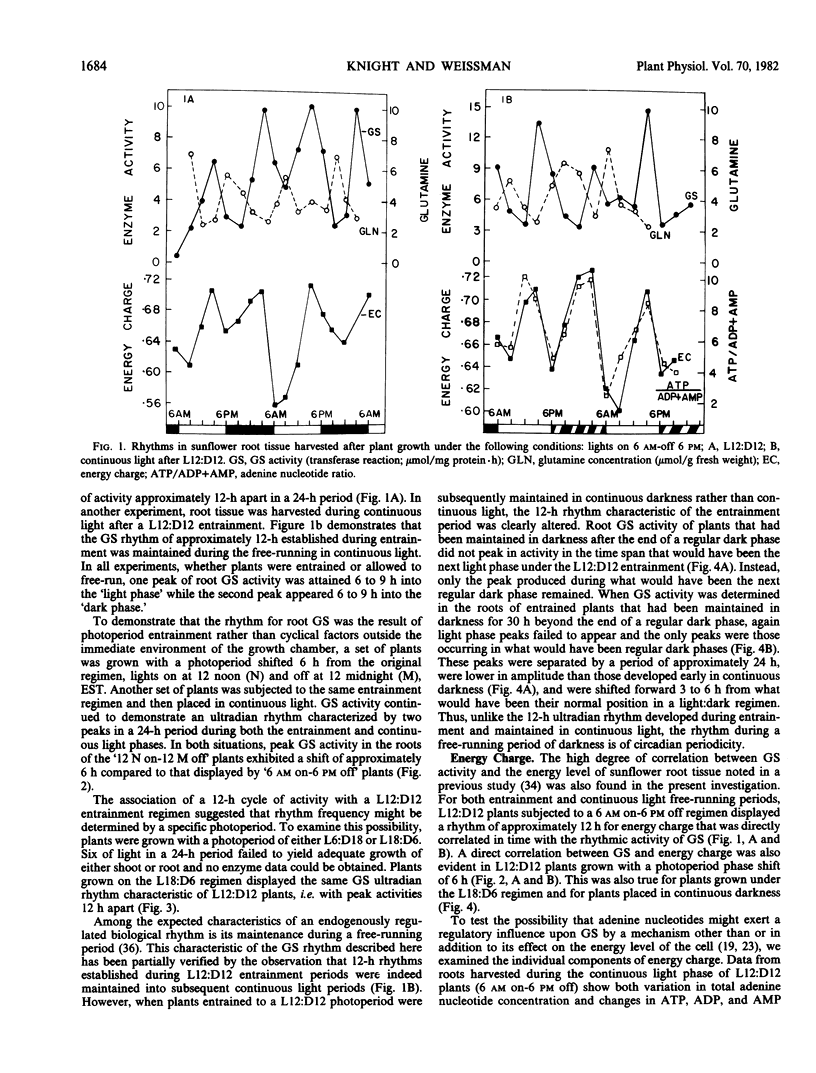
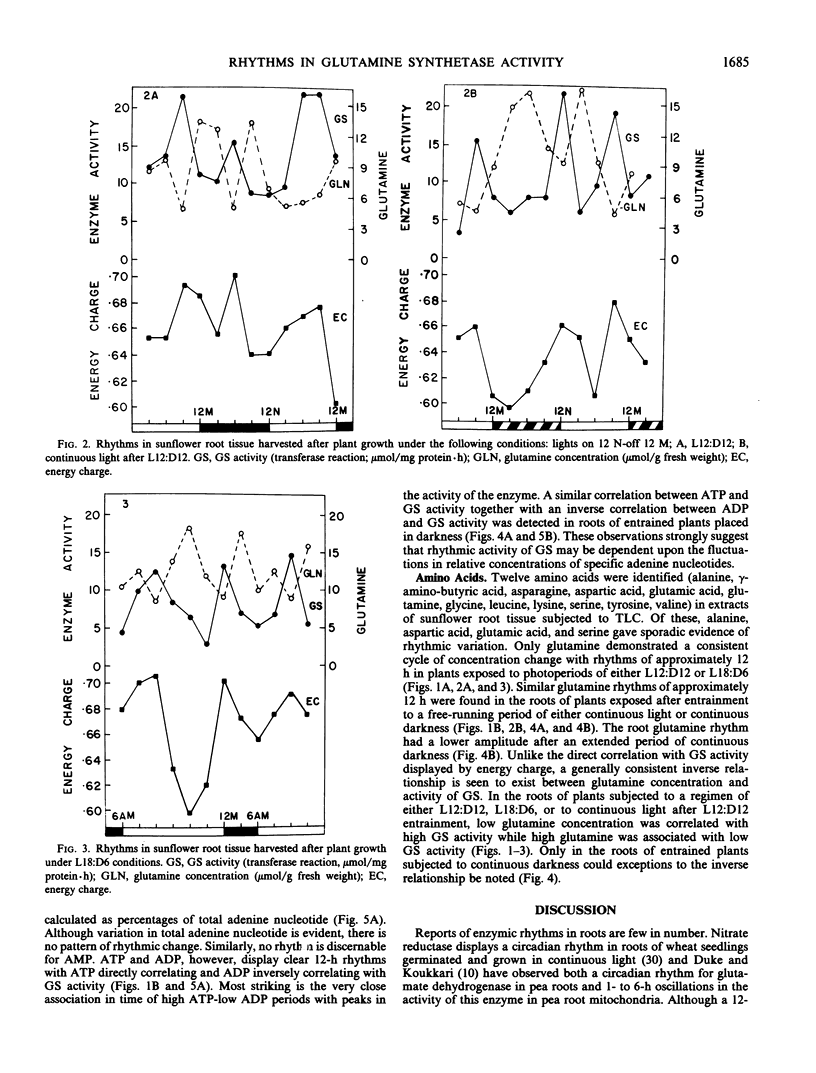

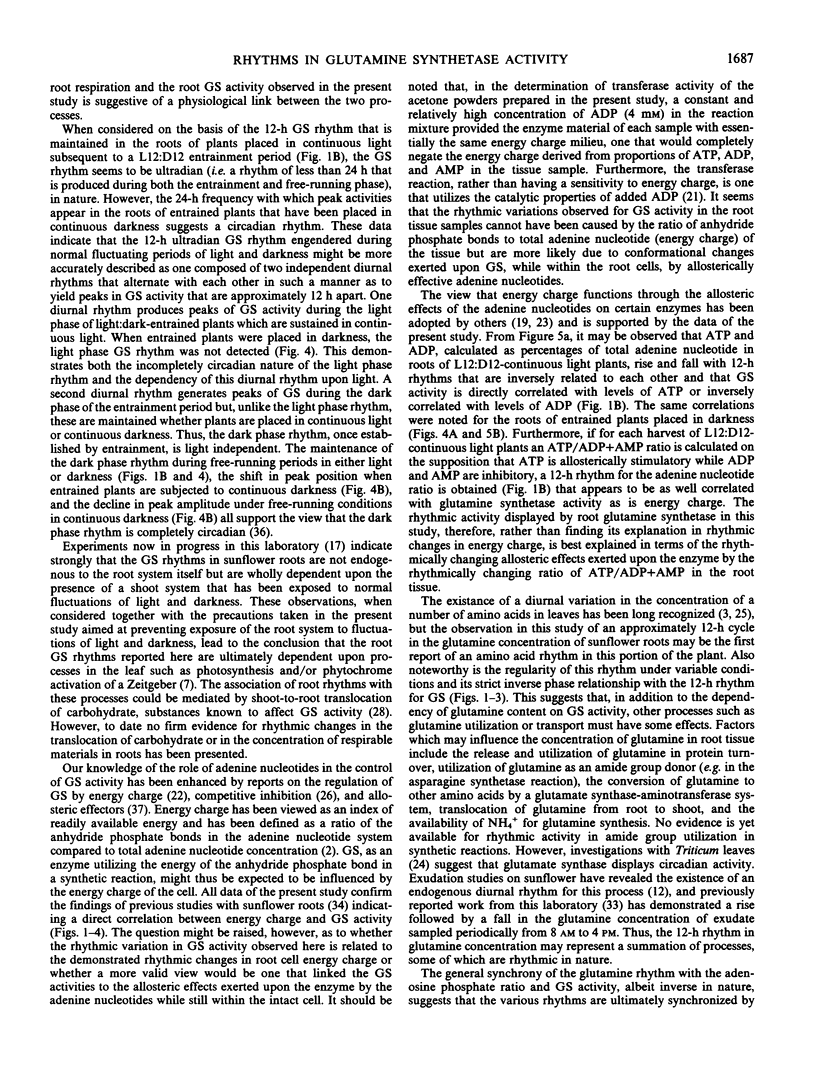
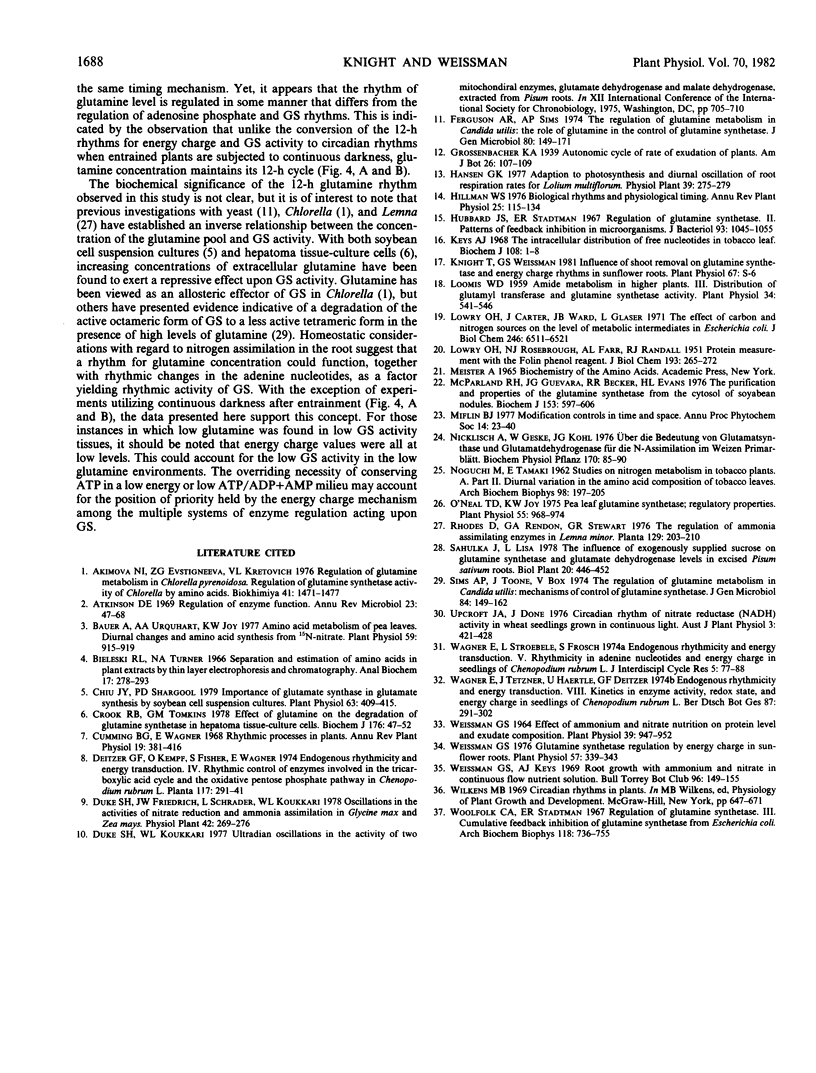
Selected References
These references are in PubMed. This may not be the complete list of references from this article.
- Akimova N. I., Evstigneeva Z. G., Kretovich V. L. Reguliatsiia metqbolizma glutamina u Chlorella pyernoidosa. Reguliatsiia aktivnosti glutaminsinettazy khlorelly aminokeslotami. Biokhimiia. 1976 Aug;41(8):1471–1477. [PubMed] [Google Scholar]
- Atkinson D. E. Regulation of enzyme function. Annu Rev Microbiol. 1969;23:47–68. doi: 10.1146/annurev.mi.23.100169.000403. [DOI] [PubMed] [Google Scholar]
- Bauer A., Urquhart A. A., Joy K. W. Amino Acid metabolism of pea leaves: diurnal changes and amino Acid synthesis from N-nitrate. Plant Physiol. 1977 May;59(5):915–919. doi: 10.1104/pp.59.5.915. [DOI] [PMC free article] [PubMed] [Google Scholar]
- Bieleski R. L., Turner N. A. Separation and estimation of amino acids in crude plant extracts by thin-layer electrophoresis and chromatography. Anal Biochem. 1966 Nov;17(2):278–293. doi: 10.1016/0003-2697(66)90206-5. [DOI] [PubMed] [Google Scholar]
- Chiu J. Y., Shargool P. D. Importance of glutamate synthase in glutamate synthesis by soybean cell suspension cultures. Plant Physiol. 1979 Mar;63(3):409–415. doi: 10.1104/pp.63.3.409. [DOI] [PMC free article] [PubMed] [Google Scholar]
- Crook R. B., Tomkins G. M. Effect of glutamine on the degradation of glutamine synthetase in hepatoma tissue-culture cells. Biochem J. 1978 Oct 15;176(1):47–52. doi: 10.1042/bj1760047. [DOI] [PMC free article] [PubMed] [Google Scholar]
- Ferguson A. R., Sims A. P. The regulation of glutamine metabolism in Candida utilis: the role of glutamine in the control of glutamine synthetase. J Gen Microbiol. 1974 Jan;80(1):159–171. doi: 10.1099/00221287-80-1-159. [DOI] [PubMed] [Google Scholar]
- Hubbard J. S., Stadtman E. R. Regulation of glutamine synthetase. II. Patterns of feedback inhibition in microorganisms. J Bacteriol. 1967 Mar;93(3):1045–1055. doi: 10.1128/jb.93.3.1045-1055.1967. [DOI] [PMC free article] [PubMed] [Google Scholar]
- Keys A. J. The intracellular distribution of free nucleotides in the tobacco leaf. Formation of adenosine 5'-phosphate from adenosine 5'-triphosphate in the chloroplasts. Biochem J. 1968 Jun;108(1):1–8. doi: 10.1042/bj1080001. [DOI] [PMC free article] [PubMed] [Google Scholar]
- LOWRY O. H., ROSEBROUGH N. J., FARR A. L., RANDALL R. J. Protein measurement with the Folin phenol reagent. J Biol Chem. 1951 Nov;193(1):265–275. [PubMed] [Google Scholar]
- Lilley R. M. Isolation of Functionally Intact Rhodoplasts from Griffithsia monilis (Ceramiaceae, Rhodophyta). Plant Physiol. 1981 Jan;67(1):5–8. doi: 10.1104/pp.67.1.5. [DOI] [PMC free article] [PubMed] [Google Scholar]
- Loomis W. D. Amide Metabolism in Higher Plants. III. Distribution of Glutamyl Tranferase and Glutamine Synthetase Activity. Plant Physiol. 1959 Sep;34(5):541–546. doi: 10.1104/pp.34.5.541. [DOI] [PMC free article] [PubMed] [Google Scholar]
- Lowry O. H., Carter J., Ward J. B., Glaser L. The effect of carbon and nitrogen sources on the level of metabolic intermediates in Escherichia coli. J Biol Chem. 1971 Nov;246(21):6511–6521. [PubMed] [Google Scholar]
- McParland R. H., Guevara J. G., Becker R. R., Evans H. J. The purification and properties of the glutamine synthetase from the cytosol of Soya-bean root nodules. Biochem J. 1976 Mar 1;153(3):597–606. doi: 10.1042/bj1530597. [DOI] [PMC free article] [PubMed] [Google Scholar]
- NOGUCHI M., TAMAKI E. Studies on nitrogen metabolism in tobacco plants. A. II. Diurnal variation in the amino acid composition of tobacco leaves. Arch Biochem Biophys. 1962 Aug;98:197–205. doi: 10.1016/0003-9861(62)90173-x. [DOI] [PubMed] [Google Scholar]
- O'neal T. D., Joy K. W. Pea leaf glutamine synthetase: regulatory properties. Plant Physiol. 1975 Jun;55(6):968–974. doi: 10.1104/pp.55.6.968. [DOI] [PMC free article] [PubMed] [Google Scholar]
- Sims A. P., Toone J., Box V. The regulation of glutamine metabolism in Candida utilis: mechanisms of control of glutamine synthetase. J Gen Microbiol. 1974 Sep;84(1):149–162. doi: 10.1099/00221287-84-1-149. [DOI] [PubMed] [Google Scholar]
- Weissman G. S. Effect of Ammonium and Nitrate Nutrition on Protein Level and Exudate Composition. Plant Physiol. 1964 Nov;39(6):947–952. doi: 10.1104/pp.39.6.947. [DOI] [PMC free article] [PubMed] [Google Scholar]
- Weissman G. S. Glutamine synthetase regulation by energy charge in sunflower roots. Plant Physiol. 1976 Mar;57(3):339–343. doi: 10.1104/pp.57.3.339. [DOI] [PMC free article] [PubMed] [Google Scholar]
- Woolfolk C. A., Stadtman E. R. Regulation of glutamine synthetase. 3. Cumulative feedback inhibition of glutamine synthetase from Escherichia coli. Arch Biochem Biophys. 1967 Mar 20;118(3):736–755. doi: 10.1016/0003-9861(67)90412-2. [DOI] [PubMed] [Google Scholar]


